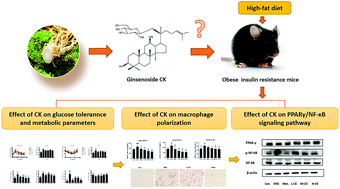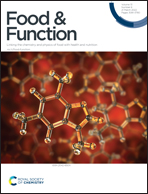Ginsenoside compound K inhibits obesity-induced insulin resistance by regulation of macrophage recruitment and polarization via activating PPARγ†
Abstract
Obesity disrupts the immune system of adipose tissue, and the activation of its macrophages constantly infiltrating adipose tissue is a crucial cause of insulin resistance induced by obesity. We previously reported for the first time in vitro that the antidiabetic effect of CK may be through the inhibition of macrophage activation and we further explored the specific mechanism in vivo. In order to clarify it, the C57BL/6J mice were fed with a high fat diet and then administered with CK orally. The related biochemical indices were detected, the inflammatory factors in serum and tissues were measured, and the related protein expression levels in insulin pathways and inflammatory signaling pathways were observed. The results showed that CK could dose-dependently reduce macrophage M1-type inflammatory factor expression in serum and adipose tissue, improve insulin resistance and glucose tolerance effectively, upregulate PPARγ expression and block TLR4/TRAF6/TAK1/NF-κB activation in obese mice. In addition, CK promoted the expression of IRS1/PI3K/AKT. Furthermore, our study showed that ginsenoside CK could improve insulin resistance by reducing inflammation through the PPARγ/NF-κB signaling pathway, which implies that ginsenoside CK may be an effective agent against obesity or early diabetes.

- This article is part of the themed collection: Food & Function Review Articles 2022

 Please wait while we load your content...
Please wait while we load your content...